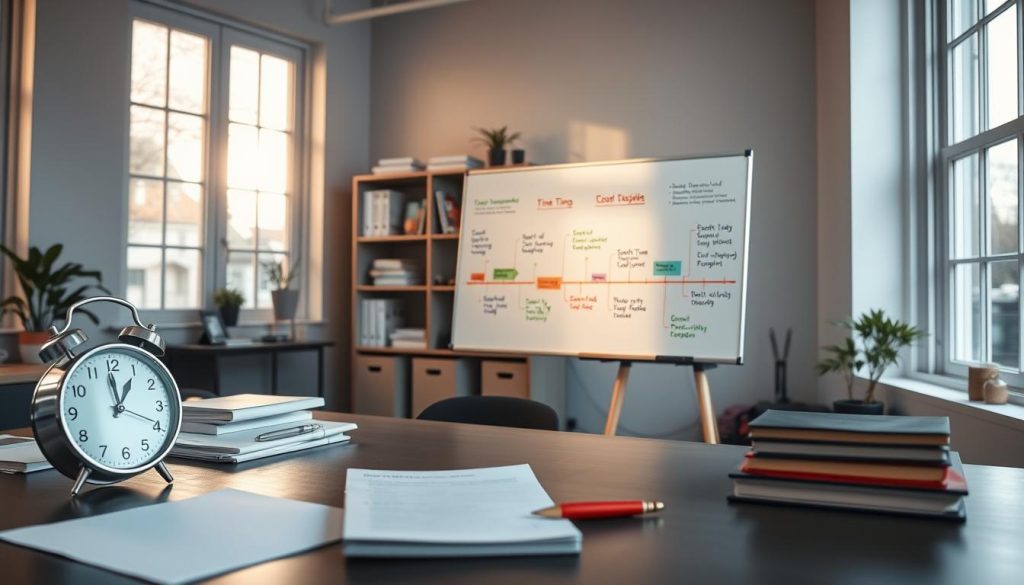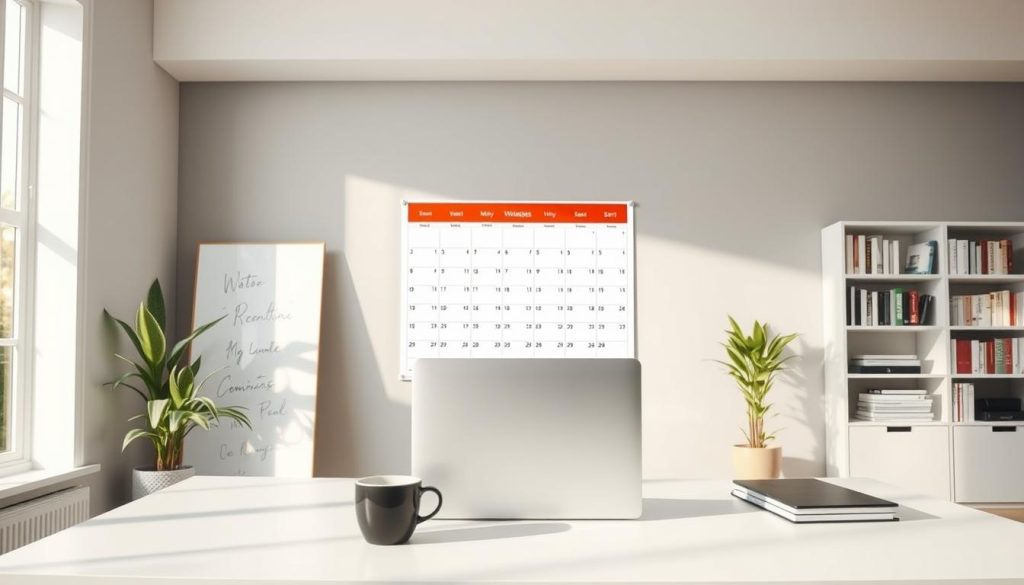Remember that first rush of excitement when you became your own boss? The freedom to choose projects, set your hours, and design your ideal workday felt empowering. Yet here you are, staring at a half-finished task while notifications ping and laundry silently judges you from the corner. Sound familiar?
Independent work offers unmatched flexibility, but 2025 Freelancer Study data reveals a harsh truth: 95% of self-employed professionals battle focus issues daily. The real challenge isn’t finding time—it’s protecting your attention from modern life’s endless demands. Without office walls or set schedules, even simple tasks can feel like climbing Everest in slippers.
We’ve helped thousands navigate this exact struggle. Through trial, error, and proven strategies, successful independents learn to transform chaotic days into purposeful workflows. Your autonomy becomes an asset, not an obstacle, when paired with the right mindset and tools.
Table of Contents
Key Takeaways
- Focus management proves more critical than time tracking for independents
- Common distractions reduce output by 40% during peak work hours
- Strategic routines combat procrastination without sacrificing flexibility
- Purposeful task alignment boosts income potential and client trust
- Hybrid accountability systems maintain motivation between projects
Embracing the Freedom and Challenges of Freelancing
The thrill of charting your own course comes with hidden currents that demand navigation. Self-directed work offers unmatched control over your professional journey, but requires mastering the art of balancing autonomy with accountability.
Recognizing the Benefits of Being Your Own Boss
Independent professionals enjoy strategic advantages traditional employees rarely experience. You choose clients who align with your values, schedule deep work during peak cognitive hours, and design workflows that maximize creative output. This flexibility lets you tackle complex projects when mental clarity is highest, often yielding superior results.
Identifying Common Pitfalls and Distractions
Without office boundaries, everyday environments become minefields of potential interruptions. Common traps include:
- Blurred lines between work hours and personal time
- Multitasking during client calls or creative sessions
- Allowing household chores to fragment concentration
Recent studies show 63% of independents struggle with « time creep » – working longer hours than salaried peers despite flexible schedules. Implementing effective work organization strategies becomes crucial for maintaining sustainable rhythms.
« Freedom in work demands responsibility for structure. The most successful independents build frameworks that channel their autonomy productively. »
Mastering this balance transforms potential weaknesses into professional strengths. By establishing clear boundaries and intentional routines, you preserve the liberating aspects of self-directed work while minimizing its inherent challenges.
Effective Time Management Strategies

Imagine your workday flowing smoothly, with each task neatly contained in its designated slot. This structured approach transforms overwhelming lists into achievable daily targets. Our research shows professionals using intentional scheduling methods complete 28% more high-value work weekly.
Implementing Time Blocking for Focused Work
Time blocking turns vague plans into concrete action. Start by categorizing work into four streams:
- Client-facing activities (calls, presentations)
- Creative development (content creation, design)
- Business operations (invoicing, emails)
- Strategic growth (networking, skill-building)
Assign specific hours to each category using digital calendars. Color-code blocks for instant visual recognition – blue for client work, green for administrative tasks. Pro tip: Schedule 15-minute buffers between blocks to handle overflow or unexpected requests.
Structuring Your Day Around Deadlines and Priority Tasks
Peak energy hours deserve your most demanding projects. If you’re sharpest before noon, block that time for complex tasks requiring deep focus. Save routine work for lower-energy periods.
At day’s end, review completed blocks and adjust tomorrow’s schedule. This 5-minute habit helps refine time estimates and identify recurring interruptions. As productivity coach Laura Vanderkam notes: « What gets scheduled gets done – even if it needs rescheduling three times first. »
Mastering the Pomodoro Technique for Enhanced Focus
Have you ever finished a work session only to realize you’ve spent 90 minutes on emails instead of priority tasks? The Pomodoro Technique transforms this common struggle into structured progress. Developed in the 1980s, this method uses timed intervals to align with your brain’s natural rhythm of concentration and recovery.
Understanding the Science Behind Focused Sprints
Our minds maintain peak performance for 20-30 minutes before needing reset. By working in 25-minute blocks followed by 5-minute pauses, you harness attention cycles proven to reduce mental fatigue. Neuroscience research shows these short bursts activate dopamine release, creating momentum that combats procrastination.
During each interval:
- Eliminate all distractions (close tabs, silence devices)
- Focus solely on one defined task
- Track completed « Pomodoros » for tangible progress
The mandatory breaks aren’t downtime – they’re recovery phases. Stand up, stretch, or hydrate to refresh your mind without engaging new stimuli. After four cycles, take a 15-30 minute break to recharge. As creator Francesco Cirillo notes: « Time becomes an ally when we respect its natural boundaries. »
This approach adapts to various work types. Creative projects might use extended 50-minute sessions, while administrative tasks benefit from rapid 25-minute sprints. For those seeking strategies for sustainable work rhythms, combining Pomodoro with time-blocking creates powerful results.
Freelance Productivity: Expert Habits for Success

Small daily actions shape long-term success more than occasional grand gestures. Professionals who thrive independently understand this truth – they design routines that convert fleeting effort into lasting momentum.
Building Micro Habits for Consistent Output
Start with simple changes: dress in work attire instead of loungewear to signal « focus mode. » Break complex projects into 30-minute action steps. Research shows this approach reduces procrastination by 47% compared to vague planning.
Effective micro habits include:
- Writing tomorrow’s three priority tasks before ending each workday
- Scheduling screen-free lunch breaks to recharge creativity
- Setting physical boundaries (closed door = deep work time)
Prioritizing High-Impact Tasks for Better Results
The Eisenhower Matrix helps separate urgent noise from meaningful work. Ask: « Does this directly serve my clients or business growth? » If not, delegate or delete it.
Top performers review their task lists weekly, eliminating low-value activities. As organizational psychologist Adam Grant advises: « Protect your attention like it’s currency – because in knowledge work, it is. »
Pair these methods with professional development strategies to handle evolving client needs. When stuck, seek peer feedback before frustration sets in – collaboration often reveals smarter solutions.
Creating a Distraction-Free Workspace
Your desk setup could be silently sabotaging your best work efforts. Research reveals environmental factors impact cognitive performance by up to 15% – equivalent to losing 90 minutes daily. Let’s transform your space into a focus fortress.
Optimizing Your Office Setup and Ergonomics
Proper alignment prevents physical strain that clouds mental clarity. Follow this checklist:
| Problem Area | Solution | Impact |
|---|---|---|
| Screen height | Top at eye level | Reduces neck strain by 40% |
| Chair support | Lumbar cushion | Improves posture 68% |
| Lighting | 500-lux desk lamp | Cuts eye fatigue by 55% |
Maintain 68-72°F room temperature for optimal focus. Poor air circulation decreases alertness – open windows hourly or use air purifiers.
Eliminating Digital and Environmental Distractions
Silence invisible attention thieves with these tactics:
- Install website blockers during deep work sessions
- Use separate devices for personal and professional tasks
- Schedule « notification windows » to batch-check messages
Ambient noise below 50 decibels enhances concentration. Try brown noise playlists to mask sudden sounds. As organizational psychologist Dr. Linda Stone notes: « The mind thrives when protected from sensory overload. »
For those seeking strategies for maintaining peak performance, remember: your workspace should serve your goals, not compete with them. Small adjustments create lasting focus dividends.
Leveraging Essential Tools and Apps
What separates thriving professionals from overwhelmed ones? Often, it’s their toolkit. Strategic tech choices act as force multipliers, turning chaotic workflows into streamlined systems. Let’s explore solutions that handle the heavy lifting so you can focus on meaningful work.
Choosing Task Management and Scheduling Solutions
Top performers treat their task lists as living documents. Platforms like Todoist simplify priority sorting with color-coded labels. Trello’s card system visualizes project stages, while Asana automates deadline reminders. The key? Pick one system and master it.
Monday.com shines for team collaborations, syncing with email and cloud storage. These tools reduce mental clutter by 32% according to 2024 workflow studies. « The right platform becomes your external brain, » notes productivity consultant Marc Zao-Sanders.
Utilizing Distraction-Busting and Focus Enhancing Apps
Digital temptations drain 2.1 hours daily. Freedom blocks social media across devices simultaneously. Forest keeps you planted by growing virtual trees during focus sessions. For auditory support, Brain.fm uses AI-generated music to boost concentration by 18%.
Financial tools like Freshbooks automate invoicing while tracking expenses. Remember: Tools should solve specific problems. Test options for two weeks before committing. Your ideal stack will feel like a tailored suit – supportive but never restrictive.
Nurturing Energy and Wellbeing Throughout Your Day
Sustaining peak performance requires more than smart workflows—it demands intentional care for your physical and mental resources. Think of your energy as a renewable battery: strategic recharging ensures consistent output without depletion.
Incorporating Regular Breaks and Mindful Practices
Short pauses every 90 minutes combat decision fatigue. Step away from screens—try a brisk walk or deep breathing exercises. Studies show workers who take longer breaks mid-day report 31% higher afternoon focus levels.
Pair movement with mental resets. A 5-minute meditation session or journaling helps process stress. As neuroscientist Dr. Amishi Jha confirms: « The mind recovers best when given true detachment from work demands. »
Developing a Healthy Sleep and Nutrition Routine
Prioritize 7-8 hours nightly—critical for cognitive repair. Create pre-bed rituals like reading or light stretching to signal rest mode. Fuel your day with protein-rich snacks and hydration to avoid energy crashes.
Batch-cook meals during lighter work hours to maintain consistent nutrition. Those mastering strategies for sustainable work-life balance often report improved client outcomes alongside personal wellbeing.
FAQ
How do I balance creative freedom with client deadlines effectively?
Use time-blocking strategies to allocate specific hours for deep work and client communication. Tools like Google Calendar or Toggl Track help visualize your schedule while leaving buffer periods for unexpected revisions.
What’s the most reliable method to prioritize tasks as a freelancer?
Apply the Eisenhower Matrix to categorize tasks by urgency and importance. Pair this with apps like Todoist or ClickUp to automate reminders and track progress on high-impact projects first.
Can the Pomodoro Technique improve focus for complex projects?
Yes. Working in 25-minute sprints with 5-minute breaks (using timers like Focus Keeper) reduces mental fatigue. For intensive tasks, adjust intervals to 50/10 cycles using Be Focused Pro for macOS/iOS compatibility.
Which tools best minimize distractions during work hours?
Cold Turkey Blocker restricts access to social media, while noise-canceling apps like Krisp filter background sounds. Pair these with ergonomic setups using standing desks from brands like FlexiSpot to maintain physical comfort.
How do I maintain energy levels during long workdays?
Schedule 15-minute breaks every 90 minutes for hydration, stretching, or brief walks. Apps like Stretchly provide reminders, while meal-prepping services like Factor ensure balanced nutrition without interrupting workflow.
What’s the optimal way to handle administrative tasks without losing billable hours?
Dedicate Friday afternoons to invoicing (via QuickBooks), contract updates (using HelloSign), and email organization. Automate recurring processes with Zapier integrations to save 4-6 hours weekly.





